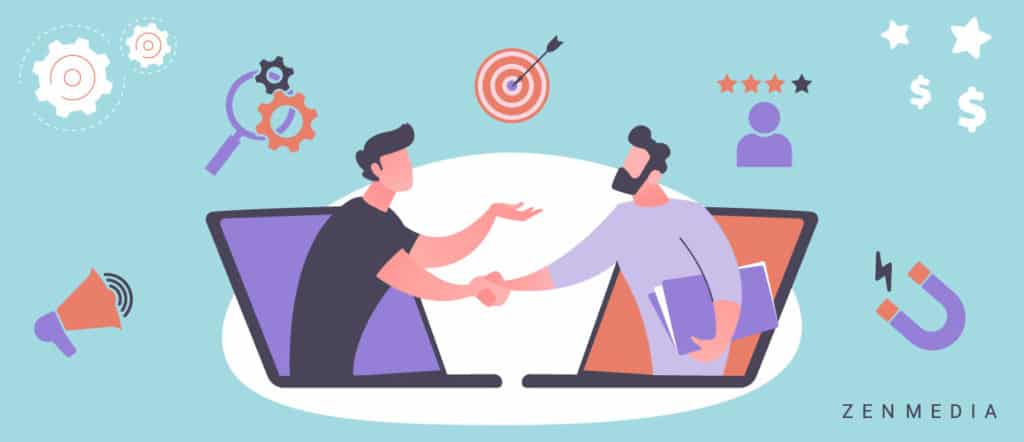Sales and business development used to be as easy as ABC: Always Be Closing. But now, sales are staggering and B2B buyers are holding off on closing deals.
As a matter of fact, only 53% of salespeople are actually achieving their quota—and that’s because sellers are finding it harder to please buyers.
When it comes to engaging with salespeople and making the first point of engagement, few are making a move at the early stages.
But why?
Blame the obstacles of the last two years, in part. Challenges of selling virtually combined with longer buying cycles have changed the buying process—and the sellers’ path as a result.
Traditional sales tactics that worked in the past won’t work now. To close the deal, you need to update your strategy, and that means backing up to the start of the buyer’s journey.
Engage Earlier—and Adapt
In B2B, the buyer journey is much longer than B2C—Forrester found in 2021 that the average B2B buyer needed 27 touchpoints before choosing to purchase. And B2B buyers are roughly 57% of the way through their buying journey before they ever engage with sales.
B2B brands can be certain that a majority of their potential buyers—72% according to the latest data—are researching their companies for weeks, months, sometimes even years before the brand ever knows they exist.
The way to engage before those 27 touchpoints and possibly years of brand awareness? Engage earlier with content marketing. B2B content marketing costs 62% less than outbound marketing and generates 3x the leads—and you could be getting your name in front of the right faces and engage even earlier.
After all, most B2B buyers want to go digital.
The digital self-serve model is preferred by 99% of B2B buyers, and they’re comfortable spending $50K or more online. In fact, a full 32% of B2B buyers would spend up to $500k online.
If you want your B2B marketing strategy to thrive in 2022, you need to adapt. Business to business interaction has changed, like everything else, due to the shifts that occurred during the height of the pandemic. Companies and consumers are now relying more and more on digital tools to find what they need, be it clients, providers, or connections.
Related post: How COVID-19 has changed the B2B buyer behavior
Become a Resource
Over the last few years, buyers have been relying less and less on sellers as go-to resources. Instead, they’re going to industry events and doing web searches before actually reaching out to a salesperson.
Plain and simple, buyers aren’t seeing salespeople as a resource when they need to solve a problem; and when they finally do decide to reach out, they’ve likely already made their decision before picking up the phone.
Actually, only 29% of buyers want to talk to a salesperson to learn more about a product. And the less time they spend interacting with you, the more valuable every minute becomes.
So are you providing valuable information that will make them stick around?
Related post: 4 Ways the B2B Sales Cycle Has Changed
Drive Their Revenue
We’ve said it before, but we’ll say it again: Relationships drive revenue.
Did you know that 80% of business buyers expect companies to respond and interact with them in real-time? And, 70% of B2B buyers cite company reputation as the most influential factor when choosing which company to do business with.
If you want to solve a business problem, find and solve the relationship problem first.
It’s paramount that you develop a trusting relationship and show them that you’ll not just close the sale with them, but help them close future sales for their business. Sellers can no longer just sell. They need to be a genuine value add and provide more than a pitch.
Buyers typically follow their instincts, which means sellers need to inspire confidence and build trust to succeed. After all, buyer apathy is real; and once that develops, it’s even more difficult to break.
Related post: The Age of Business Relations: A B2B Manifesto for the Next Decade, Powered by Cutting-Edge Industry Research
Identify a Problem They Aren’t Aware Of
By offering yourself as a subject-matter expert (SME), a salesperson becomes more than just a cog that’s there to close a transaction. You’re there to fill a void; offer value inside relevant business communities, detect unseen opportunities, create partnerships, or offer an innovative solution—or all of the above, you superstar, you!—and you’ll show the buyer what they’ve been missing and encourage earlier interactions in the future.
Deal with the FUD—Fear, Uncertainty, Doubt
No, we don’t mean the beloved Looney Tunes character, first name Elmer; fear, uncertainty, and doubt used to be a popular sales strategy. Scaring buyers into engaging used to be commonplace, but nowadays, that doesn’t guarantee a valuable relationship.
Instead, deal with the FUD in a more direct way. It was previously used as a way to provide sellers with more opportunities to deepen a relationship and differentiate themselves—but you don’t need negative emotions brewing in order to instill confidence in your capabilities.
The good news: 75% of buyers said they would be open to engaging with salespeople earlier in the buying journey under the right circumstances. So what are those circumstances?
- Risky decisions for the organization that have large legal, reputational, or financial implications
- A new challenge
- A complex decision involving several departments
- A decision that’s risky for the individual buyer
So whether you’re reaching out too late or foregoing digital altogether, one thing is for sure: There are plenty of buyers out there waiting for a subject-matter expert to capture their vision—and that starts with B2B marketing. Creating an earlier buyer journey is just the beginning.
Need a more hands-on approach? Our team of experts is always available. Get in touch here.




